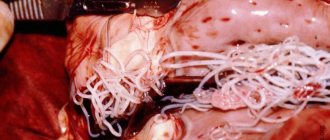Cryptorchidism in cats is the absence of one (unilateral cryptorchidism) or both (bilateral cryptorchidism) testes in the scrotum.
The testes descend into the scrotum shortly after birth. The absence of one or two testes (testes) in a cat's scrotum by six months of age can be considered cryptorchidism.
The type of inheritance of this defect is autosomal recessive. The cryptorchidism gene is present in both male and female cats and is passed on to offspring from both parents. Cryptorchidism is more often observed in purebred cats and mestizos. An undescended testis is most often located under the skin in the groin area. But sometimes it happens that the testis is located in the abdominal cavity.
Types of cryptorchidism
If the testes are in the abdominal cavity, this is abdominal cryptorchidism. The reduced testes of a cryptorchid cat are sometimes difficult to detect, as they can be hidden behind the abdominal organs or behind the intestines. An ultrasound examination is prescribed. It happens that the testes are detected only through the vas deferens.
With inguinal cryptorchidism, the testicles in the form of small tubercles are located in the groin in the subcutaneous fatty tissue. Easily palpable with fingers. Due to inexperience, they can be confused with a lymph node or a piece of fat.
There is false cryptorchidism, when the testes from the scrotum return to the abdominal cavity or inguinal canal when the animal is stressed. Then they are lowered back into the scrotum. And secondary cryptorchidism, as a complication of false cryptorchidism, when for some reason the testicles do not return to the scrotum.
There is bilateral and unilateral cryptorchidism in cats. The second one is more common.
If you don’t know anything about this phenomenon, it is difficult to notice the symptoms of cryptorchidism. Males are sexually active and often the presence of the disease does not affect mating. Although with bilateral cryptorchidism there is no spermatogenesis. If the spermatic cord is twisted, cats experience pain.
The consequence of untreated cryptorchidism is the risk of tumor formation (semenoma and sertolioma), which increases in the seventh or eighth year of a cat’s life. The fact is that for full sperm formation, the testicle must be in the scrotum at a temperature slightly lower than body temperature. With constant heating of the tissues of the testis, its structural components over time undergo gradual neoplastic degeneration and lead to the formation of tumors, which must be removed. The probability of such changes is 15 times higher than in an animal with normally located testes.
Causes
A cryptorchid cat is not at all a death sentence for the mustachioed fidget. But the owner must clearly understand the factors that can cause such an anomaly in the pet’s body structure. These include:
- Morphological changes. These include various abnormal transformations of the inguinal canal and scrotum in cats. For example, the canal is too narrow or its opening is so small, which leads to functional malfunctions in the genitourinary system. Excess connective tissue near the root of the scrotum and a short spermatic cord can also affect the development of cryptorchidism.
- Hormones. During the research, it was found that the anomaly can be provoked by a “confrontation” between the hormones secreted by the cat’s pituitary gland and testosterone. As a result, a lack of pituitary hormones prevents the ligament that promotes testicular descent from doing its job. It stops contracting fully and the testicles seem to “hang” in the wrong place - in the groin or peritoneum of the pet.
- Excessive testes size. If the pet's testicles are too large, then even with optimal development of the inguinal canal, their descent into the scrotum will be difficult.
- Impact of infection. Cryptorchidism in a meowing baby can be triggered by the fact that its parent cat suffered an illness with an infectious etiology during pregnancy or while feeding kittens with milk.
The owner must be aware that with normal development, the animal's testicles should descend after it reaches six months of age. If this does not happen, then the cat will need to be diagnosed at a veterinary clinic. After an initial clinical examination, history taking and palpation, the doctor will be able to determine the exact cause of the anomaly. In some cases, additional examination using ultrasound is permissible, especially for suspicion of an abdominal type of phenomenon.
Cryptorchidism in cats: diagnosis and treatment
Cryptorchidism in cats is detected by palpation. The animal is examined after 6 months. Upon palpation, one of the testes is usually located in the scrotum, the second is most often located in the groin area. Prolapse of the right testis is observed 2-3 times more often than the left one. Cryptorchidism as such does not pose a threat to the cat’s life and does not require treatment. But veterinarians usually suggest castration of a cryptorchid cat for three reasons:
- If it is necessary to eliminate sexual behavior;
- To exclude a given animal from breeding, since the defect is hereditary;
- Although less common than in dogs, cryptorchid cats are at risk of developing a tumor of the undescended testis.
Is it possible to remove just one testicle?
In the case of unilateral cryptorchidism, many owners are interested in the opportunity to leave the cat at least half of his male pride. However, veterinarians recommend complete castration in any case. There are no arguments against, other than male solidarity. The arguments in favor are quite weighty:
- cryptorchid is always excluded from breeding, since in any case it will inherit undesirable traits to the offspring;
- such a cat is usually more aggressive - castration will correct this;
- By removing both testicles, you will save the animal from spring suffering, and yourself from its screams and odorous marks.
Castration of a cryptorchid cat: surgical technique
The technique of castration surgery for a cryptorchid cat depends on the location of the testis. Most often, the testis is located in the groin area. To remove such a testis, the skin over it is cut. The testis is removed in a closed manner. Sutures are applied in two layers - on the subcutaneous fatty tissue and on the skin. If the testis is in the abdominal cavity, a laparotomy is performed along the white line of the abdomen. The vas deferens is found in the area of the bladder neck; by pulling it, the testis is discovered and surgically removed. The wound is sutured in layers. Removal of the testis located in the scrotum is carried out in a standard manner as during normal castration of a cat.
How is the operation performed?
It is recommended to castrate a cat with an anomaly in a clinic (not at home). A blood test and cardiac examination are performed first. The operation itself is performed under general anesthesia and lasts about an hour and a half. The descended testis is removed as standard, and the hidden testis is removed depending on the type of pathology. In the case of inguinal cryptorchidism, the hair on the abdomen is shaved, an incision is made, the testicle is cut off, the cord is cauterized or tied; in the abdominal case, the procedure is more complicated and resembles the sterilization of a cat - a long incision is made on the stomach, the testis is pulled out by the vas deferens and cut off. The procedure ends with suturing.
You can suppress a cat’s sexual activity using the Suprelorin implant.
Postoperative care for a neutered cryptorchid cat
When castrating a cryptorchid cat, postoperative care is more complex than after regular castration of a cat. After castration of a cryptorchid cat, a suture is placed on the skin. To protect the suture, a postoperative blanket is put on the cat. If the seam is in the groin area, the blanket does not always cover it well. In this case, a protective plastic collar is more suitable to protect the seam from licking. Postoperative sutures are treated with skin antiseptics (ioddicerine, betadine). The suture is removed after 10-14 days.
Why is there a problem?
Often the cause of such a problem in an animal is a genetic failure.
Signs of cryptorchidism can appear in a kitten or adult cat after surgery or mechanical damage. If your pet’s testicle has not descended after 6 months of age, this may be due to the following factors:
- Genetic disorders. Experts who breed cats have not fully figured out whether the deviation is transmitted through the maternal or paternal line, while cryptorchidism most often has a genetic nature.
- Heredity. If the inguinal canal is not wide enough, the cat’s testicles may not descend into the scrotum. The problem also develops against the background of a too short spermatic cord or with a predisposition to the adhesive process.
- Postnatal injuries observed in a kitten in early childhood.
- Infectious diseases at a young age.
- Illnesses in the cat during pregnancy or the use of strong medications during this period.
- Hormonal imbalance.
Case from practice
Cat Tikhon, mixed breed of British shorthair, 7 months. Unilateral cryptorchidism, the right testis was not palpable in the scrotum or in the groin area. An ultrasound scan of the abdominal organs was performed and a testicle was discovered under the right kidney. Castration of the right testis was carried out through laparotomy, the left - in the classical way. For the postoperative period, antibiotic therapy, treatment of postoperative wounds and sutures with skin antiseptics, and a protective blanket or protective collar are prescribed. The animal is in a satisfactory state.
When does cryptorchidism begin to develop?
The development of cryptorchidism begins in the early period of ontogenesis. The cryptorchid testis is initially (from conception) a pathological testis, and for this reason its descent into the scrotum becomes defective. Histological examination reveals underdevelopment of the convoluted seminiferous tubules and their cellular elements, and profound dystrophic changes in other structural elements of this organ. With cryptorchidism, the exocrine and endocrine (hormonal) functions of the testes are disrupted.
Normally, in a puppy, the testes descend into the scrotum two weeks after birth. It is believed that testicular descent
(one or both) can occur by 6-10 months, but later prolapse is also a developmental defect.
The causes of cryptorchidism may be the narrowness of the inguinal canal, underdevelopment of the scrotum, shortening of the spermatic cord and other mechanical factors. In one and especially bilateral cryptorchids, the reproductive function of the testes is reduced, since this function is performed only by the testis located in the scrotum.
The breeds most often prone to this disease are:
- Pug;
- English bulldog;
- Poodle;
- Yorkshire Terrier;
- Chihuahua;
- Maltese;
- Pekingese;
- Pomeranian Spitz;
- Boxer.
In cats, this pathology is much less common than in dogs (0.4-1.2%)
Let's look at the example of dogs.
Symptoms.
There is underdevelopment of the scrotum on the side where the testis is not detected by palpation. In unilateral cryptorchids, the normal testis is noticeably hypertrophied. The diagnosis is confirmed by ultrasound examination.
Treatment consists of surgical removal of the testes (castration). Moreover, both testes must be removed. Castration for cryptorchidism can be a rather difficult operation due to the difficulty of localizing an undescended testis or testes, especially given the fact that such testes are often reduced in volume (reduced).
Consequences
If a testicle has been removed from the subcutaneous area, the pet can be taken home immediately from the clinic. If the animal has undergone abdominal surgery, then in some cases a hospital stay may be required.
During the postoperative period, you need to carefully monitor your pet's condition. The owner should be wary of the following manifestations:
- severe vomiting;
- hoarse and heavy breathing;
- blue skin;
- rare and weak pulse;
- lack of reaction to light, sounds and touches 6 - 8 hours after anesthesia.
In these cases, it is necessary to urgently contact a veterinarian.
Next, we will look at the rules for caring for different types of animals in the postoperative period.
Features of castration
Castration of cryptorchid animals is similar to regular castration. The differences are in operational access. The veterinarian performs a laparotomy or laparoscopy to access and explore the abdominal cavity, with a preliminary ultrasound examination. Finding a hidden testis is the most difficult thing; it can be atypically changed, occupying a secluded place, for example, between muscle layers.
The testis does not dissolve over time; its hypertrophy is more likely to occur, and in the future - tumor-like growth. In this regard, partial castration is unacceptable.
Conclusion
When a diagnosis of cryptorchidism is made and surgical treatment of this pathology is performed, both castration and orchiopexy are possible. In terms of trauma, anesthetic risk and postoperative care, these surgical interventions are identical.
It is imperative to educate owners about the various treatment options for cryptorchidism. If it is possible to preserve a functioning organ and the owners of the animal do not plan castration, then orchiopexy is the optimal method of choosing treatment. In case of complete or partial loss of the testis, they resort to prosthetic artificial testis.
Postoperative period in horses
Castration of a cryptorchid stallion is a rather complex operation. It leaves a large wound. The recovery period takes about 2 weeks. During this period it is necessary to keep the animal on a short leash. After surgery, antibiotics and anti-inflammatory drugs are indicated.
You need to carefully monitor the cleanliness of the room and the bedding. This will help prevent the wound from becoming infected. It is necessary to protect the animal from blood-sucking insects, as they can spread infections.
For 14 days after castration, the stallion is contraindicated in any physical activity. The food should be light, since disturbances in the gastrointestinal tract negatively affect wound healing.
What is the danger of cryptorchidism?
Regardless of where exactly the undescended testicle is localized - in the abdominal or groin area, the organ will have a detrimental effect, since it is located in a foreign environment.
Veterinarians warn that the body's reproductive functions only work properly if the testicles are descended into the scrotum. This is also due to the fact that the formation and preservation of sperm viability requires a lower temperature than the animal’s body temperature.
As a result of pathology, the development of dangerous diseases is possible
Cryptorchidism negatively affects not only spermatogenesis, but also increases the risk of developing cancer pathologies. In addition, medical practice confirms that testes that are not in their environment often begin to collapse and die spontaneously, which becomes the cause of the development of an abdominal abscess.
How to identify an anomaly
Cryptorchidism can also be detected at home. To do this, you need to palpate the animal's scrotum. Normally, palpation reveals two formations similar in shape to beans. If only one testis is palpable, then in most cases this is a sign of cryptorchidism.
However, diagnosing your pet yourself can sometimes be difficult. There are also cases of false cryptorchidism. The testicular gland may become dislodged due to sudden muscle contraction. This phenomenon occurs during cold weather or when the animal is frightened. Therefore, it is better to seek help from a veterinarian. The specialist makes a diagnosis of cryptorchidism after repeated palpation of the animal.











